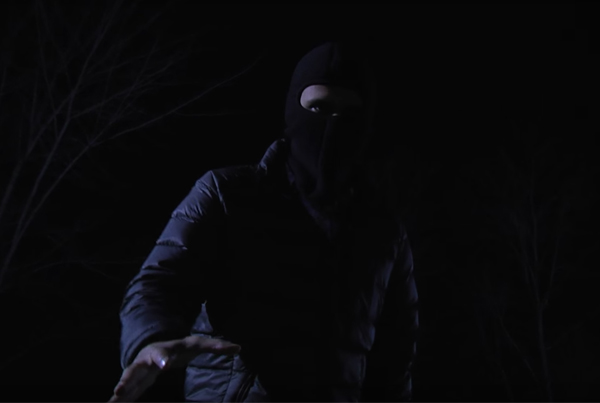ideation & brainstorming
Utilizing concepts from ubiquitous computing and pervasive interaction design, my team and I sought to create a wearable device that would make people feel safe in unsafe environments or situations. To create this device, we first started to individually brainstorm and sketch different wearables that would meet the needs of different target audiences. After several of these sessions, we agreed that we were interested in designing a device specifically for university students on campuses.
In order to properly decide how the device should look, act, and feel, we entered a long research process that included several user interviews, cultural probe and diary studies, and user enactments.
The picture to the right details one of our early concept sketches. I was often in charge of final sketches throughout the ideation and sketching process.
conducting exploratory research
Interviews
We conducted 6 interviews with students recruited both from undergraduate and graduate programs at the University of Michigan. Each interview lasted roughly 20-30 minutes long.
The most interesting finding from these interviews boiled down to this: no one liked the concept of wearables. Since our main concept had been relying on designing a wearable, we had to then reassess our project as we launched into more research.
Cultural Probe
After conducting 6 interviews, we decided to launch a cultural probe study to understand how students define safe and unsafe environments. For 2 weeks, the Graduate Student lounge at the University of Michigan School of Information hosted a box asking for students to explain what made them feel safe and unsafe.
Diary Studies
As graduate students were informing us what made them feel safe and unsafe, my team and I recruited one freshman and one senior undergraduate student from the University of Michigan. Over the period of a week, we asked them to take photos of areas where they felt unsafe in the Ann Arbor area.
At the end of the week, we requested an interview to understand what about the photos they took made them feel unsafe. During that interview, we asked that user to bring in an object that makes them feel safe. Both interviews lasted roughly an hour.
Results & Sketching
Based on the information we received from these studies and the previous interviews, my team and I had to reassess our initial wearable concept. We generated an empathy map, a word cloud based on our cultural probe, and solid interview coding in order to influence our next sketching sessions. With this information, we created three new concepts:
- Never Alone: Based on our studies, we found out that people felt more safe in numbers or with a friend. We proposed here to create a hologram that could provide companionship in moments where people felt unsafe.
- Beyond Wearables: Many of our users were skeptical of wearables. This concept would make us reassess our favored wearable concept into something new and different.
- Eliminate Fear through Design: Much fear derived from dark, unsafe environments. We proposed to create sensors and lighting structures that would trigger when people entered dark areas.
user enactments
Based on the concepts we developed after the previous round of research, we decided to embark on a series of user enactments to understand how users would react to some of our new concepts. User enactments tend to test how acceptable users finding forward-thinking design concepts and intend to make the experience as realistic as possible.
We recruited 5 graduate students and 2 undergraduate students to test our enactments. After gaining permission from the users, we launched 3 different scenarios to understand these 4 concepts:
- How comfortable are users having control or a lack of control on their devices
- How comfortable are users with anthropomorphic technology
- How concerned are users with privacy issues
- How concerned are users with surveillance technology and the “Big Brother” effect
Findings
After we conducted these enactments, we interviewed the participant for 10 minutes after to understand how they felt during our tests. Based on these interviews and our observations during the tests, we found out:
- Users feel more comfortable with physical objects in their hands when faced in dangerous situations
- No one felt comfortable with hologram technology
- Our participants felt mixed emotions about being able to control in their technologies
- They enjoyed the concept of the Internet of Things
- They felt privacy was not a concern when in the face of danger and keeping oneself safe
experience prototyping
Based on all the research we collected, we had to reformulate our concept and create a physical prototype. Since our users provided such rich feedback in the user enactments, we narrowed down that our new concept had to be something tangible, feature the Internet of Things, reflect sensitivity, and display ranging degrees of user control.
Our final prototype turned into Clipper, a small portable sensor that can be clipped onto anything the user wants. Once paired with a mobile device and other sensors, the device will monitor the user and their environment for unsafe situations. When a user feels uncomfortable or feels at risk, he or she can press a small button on the clip that will automatically call friends, family, or authorities (which is programmed and determined through the mobile device).
In moments where the user is too overwhelmed and is faced with a dangerous situation that he or she cannot react to, the device will read context, the user’s physical data, and utilize audio to detect if the situation needs to be registered to the police. Audio is then recorded for the police to use in future investigation.

